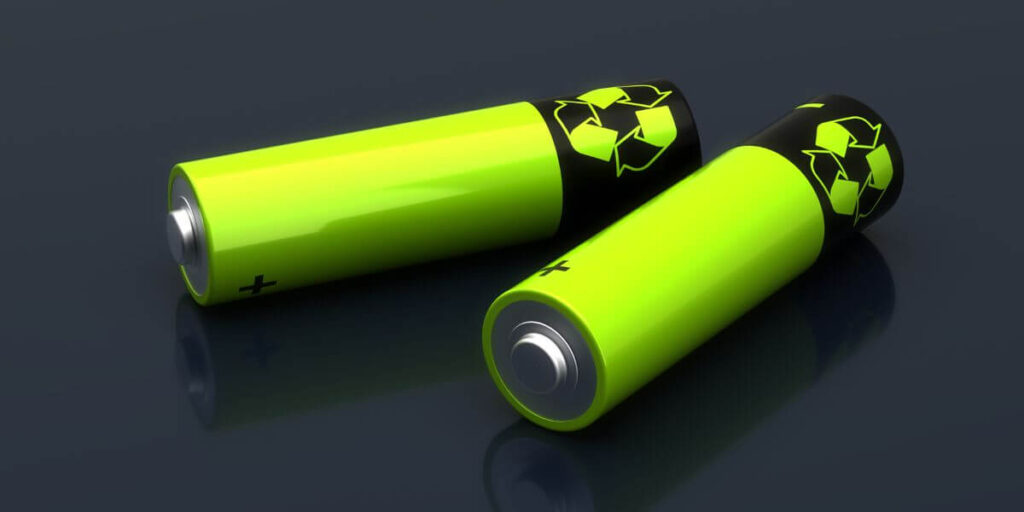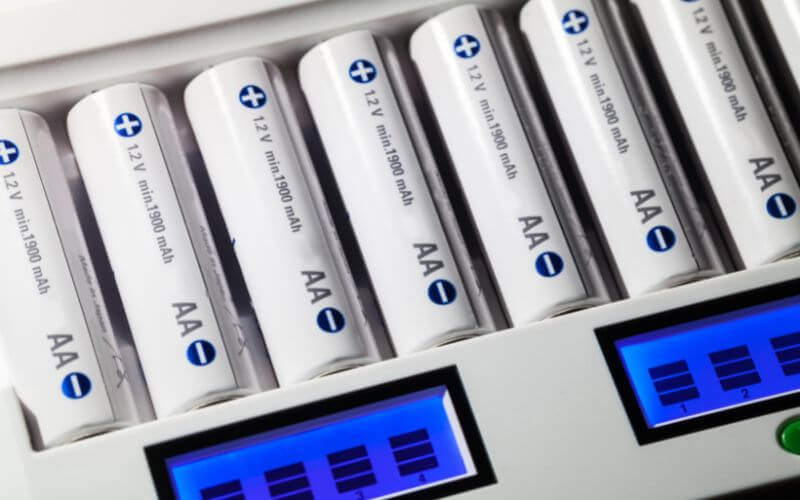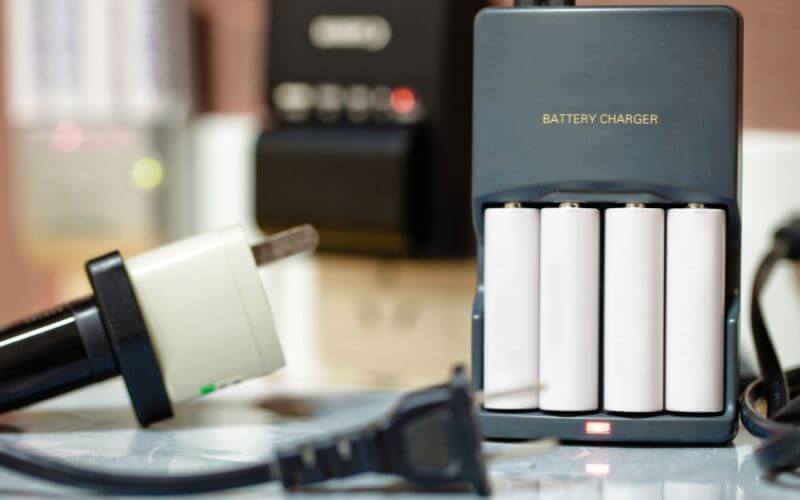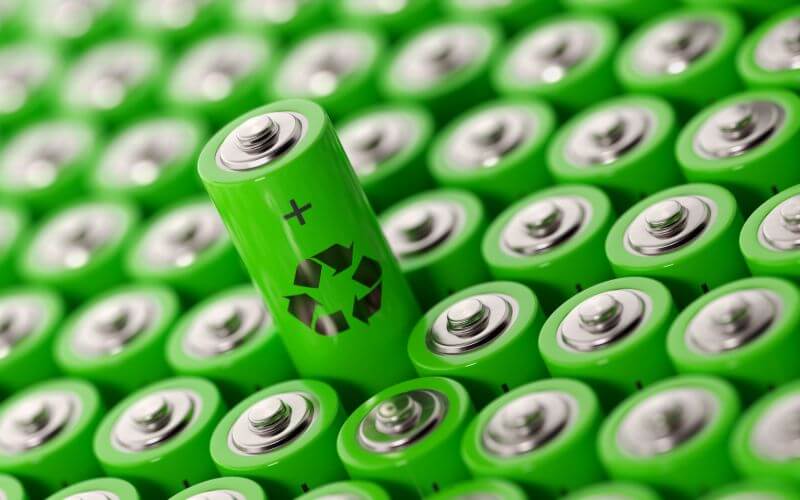Rechargeable batteries are a great way of powering your devices. Not only do they stop you from needing to constantly pay for new batteries, but you’re also helping the planet by cutting back on how many need to be manufactured in the first place.
They don’t always last forever though – both in terms of an individual charge (of course) but their overall lifespan. Eventually, a rechargeable battery may need replacing.

But how do they compare with regular batteries, and how long will they last before you need to buy more? Let’s take a look.
How long do rechargeable batteries last per charge?
There is no simple answer for how long rechargeable batteries last per charge. It depends on the battery capacity, and what it is being used for. But rechargeable batteries will normally last slightly less than regular alkaline batteries due to power leakage.
This is referred to as self-discharge, where the battery loses power even when it’s not being used, or it’ll lose more charge than the device it’s powering actually needs.
Again, there’s no clear percentage of how much worse rechargeable batteries are compared to disposable ones since battery capacities, types, and even quality vary so much.
But to return to the original question – how long does a rechargeable battery last per charge – you can work that out based on the total capacity of the battery and the power draw of the device you’re using it with.
For example, these Amazon Basics Rechargeable AA batteries have a 2400 mAh capacity, so a typical flashlight that uses 6 of these batteries and draws 3 amps of power would last for just under 5 hours.

The way you work it out is you look at the power draw of the device, and the total power of the batteries. A flashlight using 6 batteries would therefore have 6 x 2400 mAh, which is 14,400 mAh or 14.4 amps. Divide that by the power draw of the flashlight and you get 4.8 hours of usage.
Do rechargeable batteries wear out?
Older rechargeable batteries would wear out completely after around 1,000 charges, but more modern rechargeable batteries have a higher capacity and can be fully charged for 1,000 cycles before they even start to lose overall capacity.
There are essentially three types of rechargeable batteries:
1. Nickel-Cadmium (NiCd)

These are the oldest batteries that are relatively cheap to buy, and are becoming less popular. They would last for around 1,000 charges in total, depending on how you used them. The best way is to completely drain them between charges.
2. Nickel-Metal Hydride (NiMH)

Much more common now, these batteries are a bit more expensive but it’s easier to find a charger for them. They will start to deteriorate after 1,000 charges and lose some capacity, but they will still remain usable for a long time after that.
3. Lithium Ion (Li-ion)

These batteries have a much higher voltage, and don’t have the same problems with self-discharge as other types. But they will still wear out – after anything from 300 to 1,000 charges. They’re specialist batteries and are common in smartphones, but you can sometimes get them in typical AA sizes (though how safe they are is debatable). They also require a special charger.
(Source)
Why do rechargeable batteries lose their charge?
Rechargeable batteries lose their charge when they aren’t in use because of the natural chemical reactions within the cells. Long-term, the cathodes within the battery wear out, which is what causes the battery capacity to drop.
Let’s start with the self-discharge issue, where a battery drains power even when not being used. The reactions in the battery cause the battery to shed its charge at all times, but how much is lost is minuscule.
Over time it adds up though. A lithium battery will lose around 2-3% of charge per month, while a nickel-cadmium battery will lose 15-20%. Nickel-metal hydride batteries, despite being newer, are actually the worst with a 30% loss per month, although you can buy stay-charged versions which are much better, losing the same as a lithium battery.
A number of factors affect these chemical reactions, including the type of battery, how charged it is, and the ambient temperature. Keep your batteries in a cooler location to slow down the loss of charge.
The second issue is the overall lifespan of the battery, which is impacted as ions are forced from the cathode to the anode during charging, and then back in the other direction when in use. Over time the cathode is worn down by this process, and eventually, the battery will lose some capacity.
How do I know if my rechargeable batteries are still good?
You can test whether a battery is fully charged using a multimeter in DC mode. If it is close to the advertised voltage, it is fully charged. The only way to test capacity reliably is to time how long it takes to drain the battery under load.
Digital Multimeter

- Easy to use
- Ensures safety
- Accurate troubleshooting
So there are two parts to this – checking whether your battery needs to be recharged, and checking whether the battery needs to be completely replaced.
Checking the current charge is much easier, and you just need a multimeter and a resistor. Connect the resistor to the points on the multimeter using alligator clips, and then touch the points to the battery.
If it’s close to normal voltage, you know that the battery has a significant charge. If it’s lower, then the battery has lost voltage, which it will do over time with a rechargeable battery.
The video below shows exactly how to do this…
In terms of testing capacity, you can buy specialist equipment but the only way to reliably test the capacity of a battery is to fully charge it, and then time how long it takes to drain when under a load – something that you know the power draw of. And ideally it needs to be something using only one battery so that you know the accurate capacity of that battery.
So, say you have a micro flashlight that you know draws 3 amps and only needs one AA battery. You know that a 2500 mAh battery should last for around 50 minutes, because you’ve divided 2500 mAh by 3000 mAh being used, and converted 0.83 hours into minutes.
Charge the battery, switch on the flashlight, and time how long it takes to die. If it lasts for 50 minutes then it has full capacity. If it lasts 25 minutes, it’s only half capacity – and this is the point you should replace it.
How often do rechargeable batteries need to be replaced?
Rechargeable batteries vary depending on the type. NiCd batteries need replacing after 1,000 charges, while NiMH batteries will only start to deteriorate at this point, and may last much longer. Lithium-ion batteries vary depending on battery type and can last up to 5 years or more.
Lithium-ion batteries are the hardest to predict because they vary so much. A power bank may only last for 1,000 charges, but a smartphone battery will typically last three to five years. A car battery could last much longer. But they’re all different types of lithium-ion.
Generally speaking, it’s recommended that you replace a rechargeable battery once its maximum capacity has dropped to 50%.

How long do rechargeable batteries last if not used?
Lithium-ion and stay-charged NiMH batteries lose 2-3% of their charge per month when not used, so should last 50 months before needing a recharge. NiCd batteries lose 15-20% per month, so will last around 6 months.
In terms of overall lifespan, the batteries only wear down as they are charged, so if you don’t use the batteries then you won’t be wearing down the cathodes, meaning they will last as long as you need them to. You’ll just need to charge them fully when you are ready to use them.
How do you extend the life of rechargeable batteries?
Extending the life of batteries depends on their type. Older NiCd batteries should be fully discharged before charging, but NiMH and Lithium batteries should be charged once they’ve used 70% of their charge at most. Don’t overcharge batteries, and don’t keep them in hot places.
Overcharging is one way to shorten the lifespan of a battery, so make sure you disconnect the battery from the charger when it’s at full capacity. This applies whether it’s rechargeable AA or AAA batteries, or your power bank or smartphone.
And the temperature is key. High temperatures accelerate the chemical reactions inside a battery, causing it to drain quicker. Keep unused batteries in cool, dry locations.

Which rechargeable batteries last the longest?
There are two factors that influence battery life – the capacity of the battery, and the build quality. Capacity varies by size, but a high-capacity AA battery will have between 2000 and 2700 mAh. A high-capacity AAA battery will have 950-1100 mAh.
Build quality is a lot harder to judge since anyone can produce a battery. You’re best sticking with trusted brands because, while they are more expensive, they have earned that right by being a more reliable battery manufacturer.
Energizer, Duracell, and Eneloop from Panasonic are three brands you can trust to offer a long lifespan. Others may be good too, but be wary of buying cheap batteries that may seem like a good deal – they may lose their capacity a lot quicker.
Rechargeable AA Batteries

- Made with 15% recycled materials
- Can be charged hundreds of times
- Designed to prevent leaks
An important thing to note is that some rechargeable battery packs, such as power banks, actually contain cells that look a lot like AA or AAA batteries but are specialist lithium cells. You can find these lithium cells to buy in some stores, but it is not recommended that you try to replace cells yourself within a lithium battery.
Lithium cells are highly volatile and can explode or catch fire if mishandled – which is easily done, since you are working with small contact areas and solder, which must be contained only to those contacts. My advice is to just not try this and buy a whole new battery pack instead.
Is it worth buying rechargeable batteries?
In almost every case, it is worth buying rechargeable batteries – their total lifespan is much greater than a disposable battery. However, in some specific cases, it’s recommended you buy a disposable just because they lose their voltage faster.
Specifically, for anything where the power draw is minuscule, it is better to have a single-use battery since it will last a very long time, and then suddenly stop working. With a rechargeable battery, instead of a sudden stop, you may notice a gradual decrease in performance.
Examples that we’re talking about here include TV remotes and wall clocks. If you use disposable batteries you probably won’t need to change them for around 5 years, but they will work as intended right up to the point that they stop.
With rechargeable batteries, the remote may work incorrectly, or the clock may slow down – which can be pretty annoying if you rely on it for your morning routine.
Anything which requires new batteries every 1 to 2 years, or more frequently, should use rechargeable. But for devices with a super-low power draw, it may be worth sticking with disposable ones for now.
Anyone with kids will know that those noisy toys with flashing lights wear down batteries real quick! So investing in some rechargeable batteries for those is well worth it.

Rechargeable Battery FAQs
Hearing aid battery life varies depending on the brand of hearing aid and the battery used. Oticon recommends that its hearing aids have their batteries replaced every year, while Signia batteries last for around 3 years, retaining 80% of their initial capacity after 2 years.
Vape manufacturers have varying recommendations for battery life. Expect your vape to last between 300 and 800 puffs between charges, while the battery itself will need fully replacing after 6-12 months. Vapes are often used intensively and so batteries need to be charged and replaced more frequently.
Solar lights will either have NiMH batteries that last up to 2 years, or lithium batteries that last up to 5 years. Some cheaper lights have sealed batteries, so the entire light needs replacing when the battery dies. Conserve power by storing solar lights in a dark space during winter.
The lifespan of a rechargeable lithium battery will vary but they are usually guaranteed for at least 500 charging cycles. It depends on the battery type and manufacturer – smartphone lithium batteries often last longer, up to an average of 3-5 years.
The average lifespan of typical AA batteries in an Xbox One controller is 40 hours, while rechargeable AA batteries or a Play & Charge Kit will usually last for an average of 30 hours. Play & Charge kits tend to deteriorate faster than rechargeable AA batteries, but are popular for their convenience.
